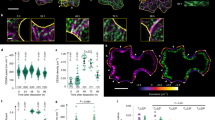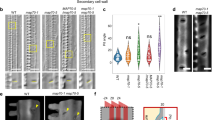Abstract
Plant-cell expansion is controlled by cellulose microfibrils in the wall1 with microtubules providing tracks for cellulose synthesizing enzymes2. Microtubules can be reoriented experimentally3,4,5,6,7,8,9,10,11 and are hypothesized to reorient cyclically in aerial organs12,13,14, but the mechanism is unclear. Here, Arabidopsis hypocotyl microtubules wershee labelled with AtEB1a–GFP (Arabidopsis microtubule end-binding protein 1a) or GFP–TUA6 (Arabidopsis α-tubulin 6) to record long cycles of reorientation. This revealed microtubules undergoing previously unseen clockwise or counter-clockwise rotations. Existing models emphasize selective shrinkage and regrowth15 or the outcome of individual microtubule encounters to explain realignment16. Our higher-order view emphasizes microtubule group behaviour over time. Successive microtubules move in the same direction along self-sustaining tracks. Significantly, the tracks themselves migrate, always in the direction of the individual fast-growing ends, but twentyfold slower. Spontaneous sorting of tracks into groups with common polarities generates a mosaic of domains. Domains slowly migrate around the cell in skewed paths, generating rotations whose progressive nature is interrupted when one domain is displaced by collision with another. Rotary movements could explain how the angle of cellulose microfibrils can change from layer to layer in the polylamellate cell wall.
This is a preview of subscription content, access via your institution
Access options
Subscribe to this journal
Receive 12 print issues and online access
$209.00 per year
only $17.42 per issue
Buy this article
- Purchase on Springer Link
- Instant access to full article PDF
Prices may be subject to local taxes which are calculated during checkout




Similar content being viewed by others
References
Giddings, T. H. & Staehelin, A. Microtubule-mediated control of microfibril deposition: A re-examination of the hypothesis (ed. Lloyd, C. W.) (Academic Press Ltd., London, 1991).
Paredez, A. R., Somerville, C. R. & Ehrhardt, D. W. Visualization of cellulose synthase demonstrates functional association with microtubules. Science 312, 1491–1495 (2006).
Iwata, T. & Hogetsu, T. The effect of light irradiation on the orientation of microtubules in seedlings of Avena sativa L. Plant Cell Physiol. 30, 1011–1016 (1989).
Nick, P., Bergfeld, R., Schafer, E. & Schopfer, P. Unilateral reorientation of microtubules at the outer epidermal wall during photo- and gravitropic curvature of maize coleoptiles and sunflower hypocotyls. Planta 181, 162–168 (1990).
Laskowski, M. Microtubule orientation in pea stem cells: a change in orientation follows the initiation of growth rate decline. Planta 181, 44–52 (1990).
Ishida, K. & Katsumi, M. Immunofluorescence microscopical observation of cortical microtubule arrangement as affected by gibberellin d5 mutant of Zea mays L. Plant Cell Physiol. 32, 409–417 (1991).
Ishida, K. & Katsumi, M. Effects of gibberelin and abscisic acid on the cortical microtubule orientation in hypocotyls of light-grown cucumber seedlings. Int. J. Plant Sci. 153, 155–163 (1992).
Zandomeni, K. & Schopfer, P. Reorientation of microtubules at the outer epidermal wall of maize coleoptiles by phytochrome, by blue-light photoreceptor and auxin. Protoplasma 173, 103–112 (1993).
Yuan, M., Shaw, P. J., Warn, R. M. & Lloyd, C. W. Dynamic reorientation of cortical microtubules, from transverse to longitudinal, in living plant cells. Proc. Natl Acad. Sci. USA 91, 6050–6053 (1994).
Lloyd, C. W., Shaw, P. J., Warn, R. M. & Yuan, M. Gibberellic acid-induced reorientation of cortical microtubules in living plant cells. J. Micros. 181, 140–144 (1996).
Ueda, K. & Matsuyama, T. Rearrangement of cortical microtubules from transverse to oblique or longitudinal in living cells of transgenic Arabidopsis thaliana. Protoplasma 213, 28–38 (2000).
Mayumi, K. & Shibaoka, H. The cyclic reorientation of cortical microtubules on walls with a crossed polylamellate structure: effects of plant hormones and an inhibitor of protein kinases on the progression of the cycle. Protoplasma 195, 112–122 (1996).
Takesue, K. & Shibaoka, H. The cyclic reorientation of cortical microtubules in epidermal cells of azuki bean epicotyls: the role of actin filaments in the progression of the cycle. Planta 205, 539–546 (1998).
Hejnowicz, Z. Autonomous changes in the orientation of cortical microtubules underlying the helicoidal cell wall of the sunflower hypocotyl epidermis: spatial variation translated into temporal changes. Protoplasma 225, 243–256 (2005).
Yuan, M., Warn, R. M., Shaw, P. J. & Lloyd, C. W. Dynamic microtubules under the radial and outer tangential walls of microinjected pea epidermal cells observed by computer reconstruction. Plant J. 7, 17–23 (1995).
Dixit, R. & Cyr, R. Encounters between dynamic cortical microtubules promote ordering of the cortical array through angle-dependent modifications of microtubule behavior. Plant Cell 16, 3274–3284 (2004).
Sugimoto, K., Willamson, R. E. & Wasteneys, G. O. New techniques enable comparative analysis of microtubule orientation, wall texture, and growth rate in intact roots of Arabidopsis. Plant Physiol. 124, 1493–1506 (2000).
Buschmann, H. et al. Helical growth of the Arabidopsis mutant tortifolia1 reveals a plant-specific microtubule-associated protein. Curr. Biol. 14, 1515–1521 (2004).
Le, J., Vandenbussche, F., De Cnodder, T., Van Der Straeten, D. & Verbelen, J.-P. Cell elongation and microtubule behavior in the Arabidopsis hypocotyl: responses to ethylene and auxin. J. Plant Growth Regul. 24, 166–178 (2005).
Nakajima, K., Kawamura, T. & Hashimoto Role of the SPIRAL1 gene family in anisotropic growth of Arabidopsis thaliana. Plant Cell Physiol. 47, 513–522 (2006).
Hush, J. M., Wadsworth, P., Callaham, D. A. & Hepler, P. K. Quantification of microtubule dynamics in living plant cells using fluorescence redistribution after photobleaching. J. Cell Sci. 107, 775–784 (1994).
Shaw, S. L., Kamyar, R. & Ehrhardt, D. W. Sustained microtubule treadmilling in Arabidopsis cortical arrays. Science 300, 1715–1718 (2003).
Chan, J., Calder, G., Fox, S. & Lloyd, C. Localization of the end-bidning protein EB1 reveals alternative pathways of spindle development in Arabidopsis suspension cells. Plant Cell 17, 1737–1748 (2005).
Chan, J., Calder, G. M., Doonan, J. H. & Lloyd, C. W. EB1 reveals mobile microtubule nucleation sites in Arabidopsis. Nature Cell Biol. 5, 967–971 (2003).
Dhonukshe, P., Mathur, J., Hulskamp, M. & Gadella, T. W., Jr. Microtubule plus-ends reveal essential links between intracellular polarization and localized modulation of endocytosis during division-plane establishment in plant cells. BMC Biol 3, 11 (2005).
Dixit, R., Chang, E. & Cyr, R. Establishment of polarity during organization of the acentrosomal plant cortical microtubule array. Mol. Biol. Cell. 17, 1298–1305 (2006).
Gendreau, E. et al. Cellular basis of hypocotyl growth in Arabidopsis thaliana. Plant Physiol. 114, 295–305 (1997).
Refrégier, G., Pelletire, S., Jaillard, D. & Höfte, H. Interaction between wall deposition and cell elongation in dark-grown hypocotyl cells in Arabidopsis. Plant Physiol. 135, 1–10 (2004).
Ueda, K., Matsuyama, T. & Hashimoto, T. Visualization of microtubules in living cells of transgenic Arabidopsis thaliana. Protoplasma 206, 201–206 (1999).
Penfold, R., Watson, A. D., Mackie, A. R. & Hibberd, D. J. Quantitative imaging of aggregated emulsions. Langmuir 22, 2005–2015 (2006).
Costa, M. M., Fox, S., Hanna, A. I., Baxter, C. & Coen, E. Evolution of regulatory interactions controlling floral asymmetry. Development 132, 5093–5101 (2005).
Acknowledgements
We are grateful to E. Coen for useful discussions, H. Jones for technical support, J. Rothe for assistance with time-lapse montages and A. Mackie for assistance with vertical imaging. The work was funded by a grant-in-aid to the John Innes Centre by the Biotechnology and Biological Sciences Research Council.
Author information
Authors and Affiliations
Contributions
J.C. contributed to project planning, collection of experimental data, data analysis, supervision and writing. G.C. contributed to the collection of experimental data and data analysis. S.F. produced the AtEB1–GFP lines. C.L. was responsible for supervision and writing.
Corresponding author
Ethics declarations
Competing interests
The authors declare no competing financial interests.
Supplementary information
Supplementary Information
Supplementary Graph S1, Figures S1, S1 and References (PDF 325 kb)
Supplementary Information
Supplementary Movie S1 (MOV 2525 kb)
Supplementary Information
Supplementary Movie S2 (MOV 2930 kb)
Supplementary Information
Supplementary Movie S3 (MOV 1798 kb)
Supplementary Information
Supplementary Movie S4 (MOV 454 kb)
Supplementary Information
Supplementary Movie S5 (MOV 1369 kb)
Supplementary Information
Supplementary Movie S6 (MOV 1975 kb)
Supplementary Information
Supplementary Movie S7 (MOV 1908 kb)
Supplementary Information
Supplementary Movie S8 (MOV 1792 kb)
Supplementary Information
Supplementary Movie S9 (MOV 1199 kb)
Rights and permissions
About this article
Cite this article
Chan, J., Calder, G., Fox, S. et al. Cortical microtubule arrays undergo rotary movements in Arabidopsis hypocotyl epidermal cells. Nat Cell Biol 9, 171–175 (2007). https://doi.org/10.1038/ncb1533
Received:
Accepted:
Published:
Issue Date:
DOI: https://doi.org/10.1038/ncb1533
This article is cited by
-
Structure and growth of plant cell walls
Nature Reviews Molecular Cell Biology (2023)
-
Are microtubules tension sensors?
Nature Communications (2019)
-
Proteomic Identification of Differentially Altered Proteins During Regeneration from Nodular Cluster Cultures in Vriesea reitzii (Bromeliaceae)
Journal of Plant Growth Regulation (2019)
-
A new kymogram-based method reveals unexpected effects of marker protein expression and spatial anisotropy of cytoskeletal dynamics in plant cell cortex
Plant Methods (2017)
-
Proteomic profiling of cellulase-aid-extracted membrane proteins for functional identification of cellulose synthase complexes and their potential associated- components in cotton fibers
Scientific Reports (2016)



